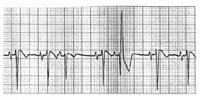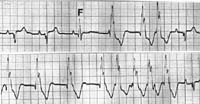| Admissions | Accreditation | Booksellers | Catalog | Colleges | Contact Us | Continents/States/Districts | Contracts | Examinations | Forms | Grants | Hostels | Honorary Doctorate degree | Instructors | Lecture | Librarians | Membership | Professional Examinations | Programs | Recommendations | Research Grants | Researchers | Students login | Schools | Search | Seminar | Study Center/Centre | Thesis | Universities | Work counseling |
|
ECG Quiz Question 1 of 10  What is the diagnosis of the FLB (funny-looking-beat) in this Lead V1 ECG rhythm strip? A. It's a PAC with LBBB aberration B. It's a PAC with RBBB aberration C. It's a PVC from the right ventricle D. It's a PVC from the left ventricle The correct answer is B. Notice the rsR' complex and the preceding premature P-wave. |
Question 2 of 10 In this V1 rhythm strip, what does the 'F' imply? A. 'F' is for "Funny-looking-beat" B. 'F' is for "failure-to-capture" which implies the sinus P wave can't get into the ventricles. C. 'F' is for "fusion beat"; i.e. the fusion of a right ventricular PVC with the sinus initiated QRS complex. D. 'F' is for "fusion beat"; i.e. the fusion of a left ventricular PVC with the sinus initiated QRS complex. Correct! The subsequent ventricular ectopics are upgoing (anterior oriented) QRSs, suggestion origin from the LV. The correct answer is D. |
Question 3 of 10 In this V1 rhythm strip look at the wide QRS rhythm. Why do the RR intervals vary? A. This is a ventricular tachycardia with intermittent 2:1 exit block. B. This is paroxysmal atrial fibrillation with RBBB aberrency. C. This is a ventricular escape rhythm alternating with ventricular tachycardia. D. This is sinus rhythm with a rate-related right bundle block. Correct! The longer RR intervals are twice the short intervals suggesting that not every impulse form the ventricular focus makes it out to the rest of the ventricles. The correct answer is A. |
Question 4 of 10 In this V1 rhythm strip there are 4 FLB’s (Funny-looking-beats) in addition to the normal sinus beats. What are they? A. These are multifocal PVCs. B. The first FLB is a late onset PVC, and the other three are fusion beats. C. Intermittent right bundle branch block (RBBB) D. Intermittent WPW type preexcitation. Correct! Late PVCs often occur coincidentally with sinus activation of the ventricles. The degree of fusion may vary as seen in this example. The correct answer is B. |
Question 5 of 10 In this V1 rhythm strip, what degree of AV block (if any) is present? A. 1st degree AV block B. 2nd degree AV block C. 3rd degree AV block D. No AV block; this is complete AV dissociation Correct! Some P waves conduct, and some do not. The correct answer is B. |
Question 6 of 10 In this V1 rhythm strip, what do the 'e' and 'c' represent. A. The ‘e’ represents a ventricular echo beat form the nonconducted P wave. The 'c' is a sinus capture. B. The 'e' is for ventricular escape. The 'c' is a PAC. C. The 'e' is a junctional escape, and 'c' represents a PAC. D. The 'e' represents a junctional escape beat; the 'c' represents a sinus capture. Correct! Sometimes this goes by the name of "escape-capture bigeminy". Any pause in the rhythm may result in an escape beat if the pause is too long. The correct answer is D. |
Question 7 of 10 This somewhat perplexing rhythm strip has a rather simple explanation. What is it? A. Junctional rhythm with occasional PVC B. Complete AV block; junctional escape rhythm; occasional PVC C. Sinus rhythm with 1st degree AV block; occasional PVC D. Junctional rhythm, PVC, and nonconducted PAC Correct! Thanks to the PVC and resulting pause, the sinus P wave becomes separated form the preceding T wave. The 1st degree AV block is quite marked. The correct answer is C. |
Question 8 of 10 This facinating V1 rhythm strip has several interesting features. What’s the likely cause of the pauses in the rhythm? A. 2nd degree AV block (Type I, Wenckebach) B. 2nd degree AV block (Type II, Mobitz) C. Nonconducted PACs D. Marked sinus arrhythmia Correct! This is the most common cause of an unexpected pause in the rhythm. The P-waves of the PACs are early relative to the sinus PP intervals. The correct answer is C. |
Question 9 of 10
This facinating V1 rhythm strip has several interesting features. What event terminates the pauses? A. A sinus beat that has been reset by the PAC. B. A ventricular escape beat C. An electronic pacemaker beat originating from the right ventricle. D. A junctional escape complex. Correct! Actually the sinus P wave is seen partially superimposed on the junctional escape beat thereby distorting the onset of the QRS. The correct answer is D. |
Question 10 of 10 What is the diagnosis of this bigeminal rhythm? A. 2nd degree AV block type II (Mobitz) B. Nonconducted PACs following every two consecutive sinus beats. C. 2nd degree AV block (Type I, Wenckebach) D. Sino-atrial exit block Correct! The PR intervals for two consecutive beats are constant, followed by a blocked sinus P wave. The QRS is wide suggesting a bundle branch block. The correct answer is A. |
| http://library.med.utah.edu/kw/ecg/tests/index.html |
